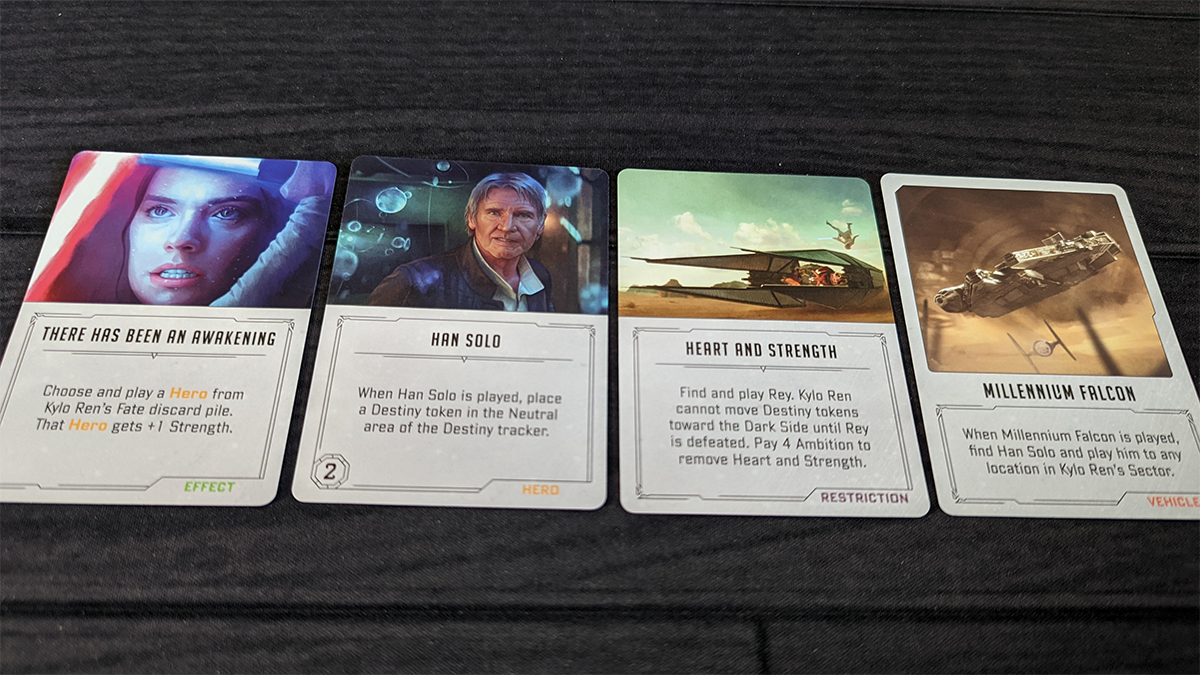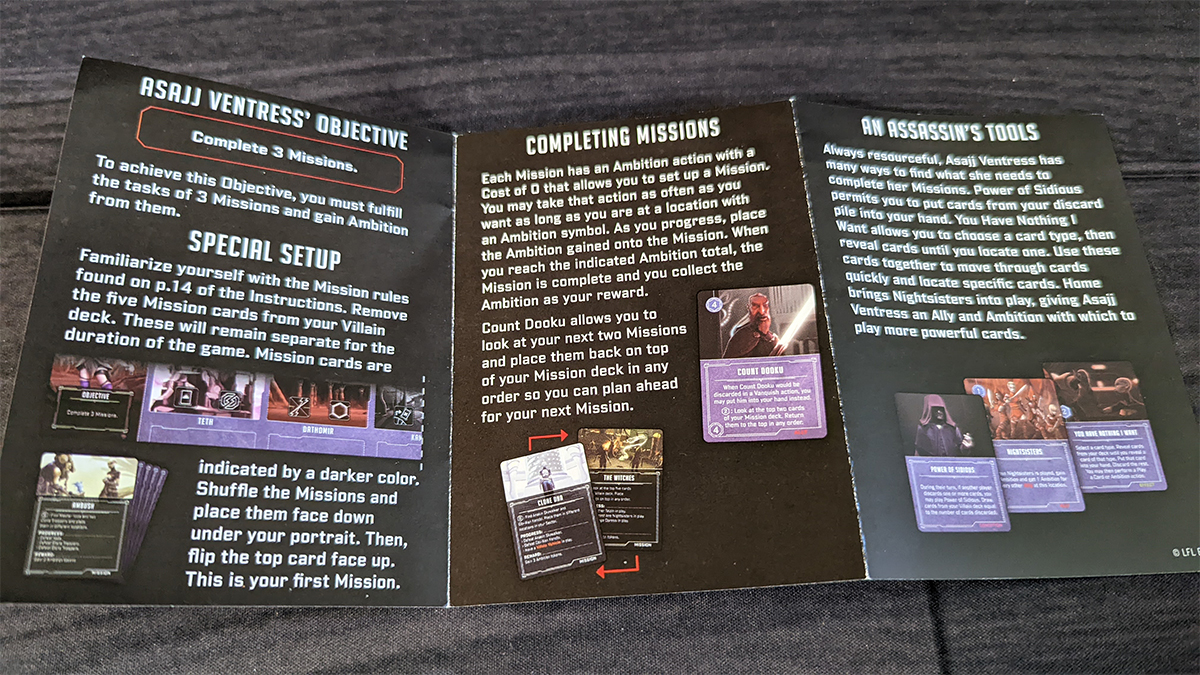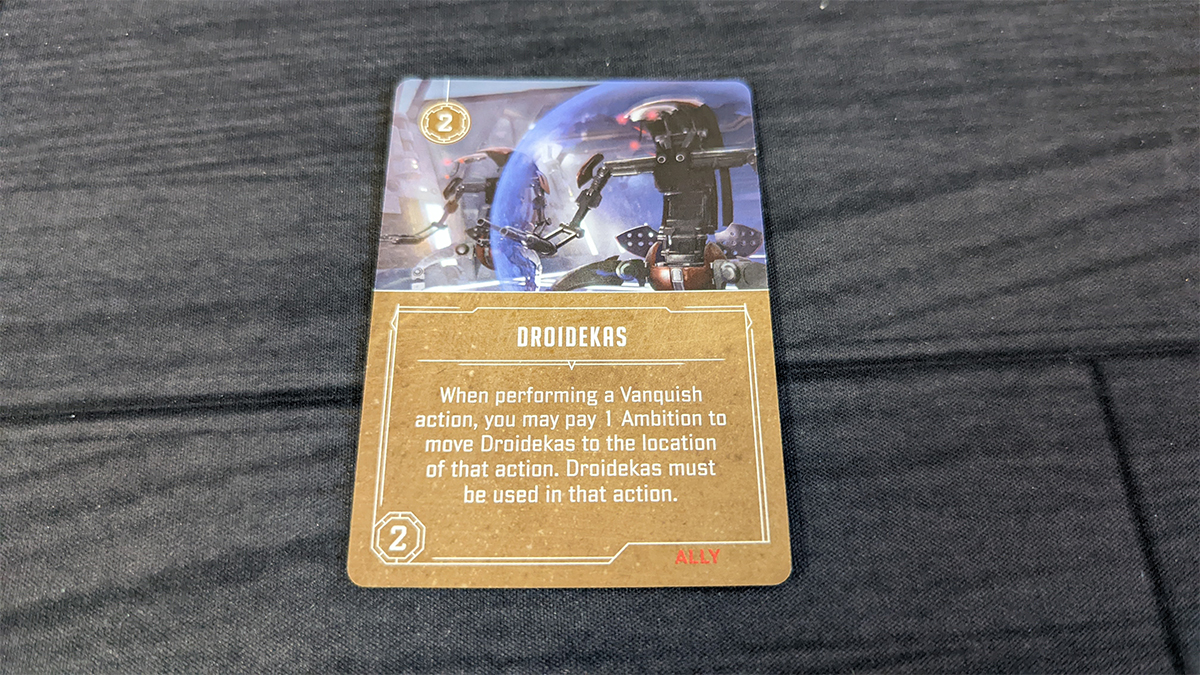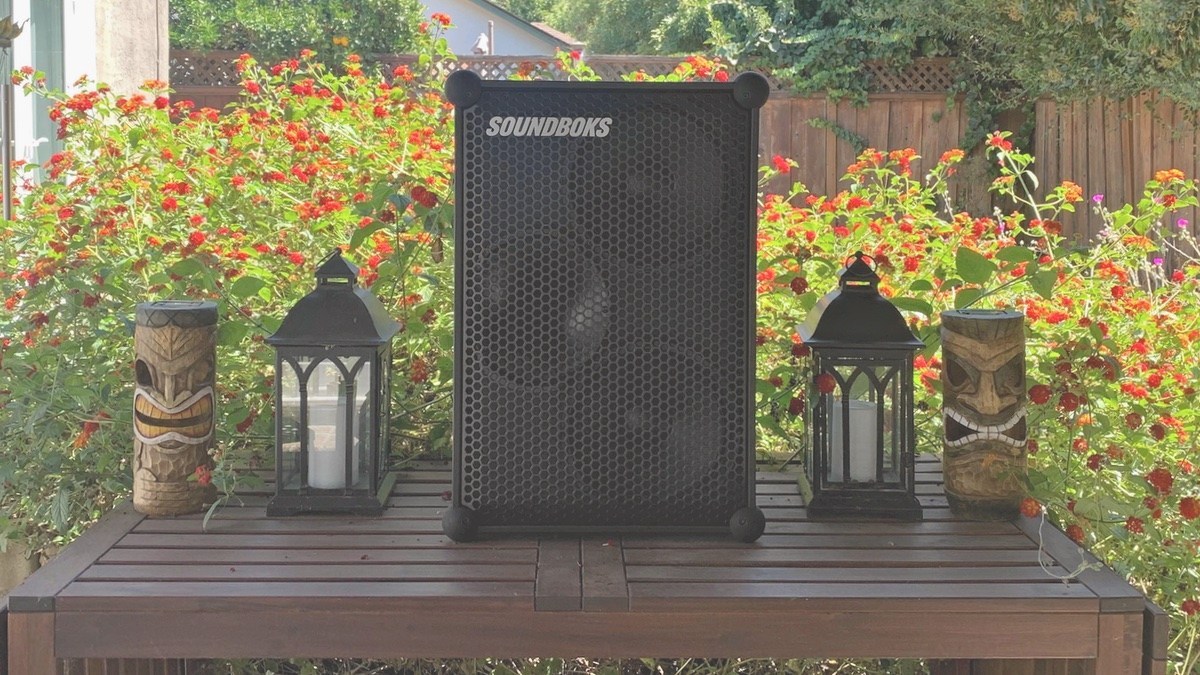Ravensburger has been busy expanding its Villainous series for a few years now, bringing Disney villains good and bad to the game. They expanded into Disney’s Marvel properties with a stand-alone game in 2020, and now, at last, they have brought the game into the Star Wars universe as well.
What Is Star Wars Villainous: Power of the Dark Side?
Star Wars Villainous: Power of the Dark Side is a game for 4 players, ages 10 and up, and takes about 20 minutes per player to play. It’s currently available now from Target and Amazon retailing for $39.99. The game is due to become available everywhere in September.
The game was designed by Mike Mulvihill, based on the Villainous Game System designed by Prospero Hall. The game was art directed by Jake Breish, with graphic design by Chris Buckley.
Note that Star Wars Villainous is not compatible with either any of the Disney Villainous games or with Marvel Villainous.
Power of the Dark Side Components

Inside the box, you’ll find:
- 5 Villain Movers
- 5 Player Boards
- 5 Villain Decks, each with 30 cards
- 5 Fate Decks, each with 15 cards
- 2 special tiles (Luke Skywalker and Destiny Tracker)
- 25 cardboard credit tokens
- 25 cardboard ambition tokens
- 15 cardboard strength tokens
- 8 cardboard lightsaber tokens
- 6 cardboard destiny tokens
- 5 Villain Guides
- 5 Reference Cards
- 1 chamber
The components in this game will be immediately familiar to fans of any of the other Villainous titles, albeit with some new elements.
As always, one of the more visually interesting design elements throughout the Villainous franchise is the movers. Rather than going with miniatures or cardboard standees of the characters, the game’s designers came up with these really cool abstract models. Each is totally unique, and yet so well thought-out that they are obviously the character they represent.
Power of the Dark Side’s villains span the range of the current Star Wars universe: General Grievous from the prequels and Clone Wars, Asajj Ventress from the Clone Wars series, Moff Gideon from The Mandalorian, and Kylo Ren from the sequels. And, obviously, Darth Vader.





Grievous’ mover is off-white with the general’s mask supported by his lightsaber collection. Ventress is purple and, like the character, almost unusually skinny (it is perhaps the skinniest of all Villainous movers) with her curved sabers strapped to her back. Gideon’s deep red mover invokes the character’s haughtiness from the series and features the handle of the Darksaber. Kylo is a darker red, with his mask and unique lightsaber making up the shape of the piece. And with Vader, the designer managed to combine most of the familiar elements of the character, from the mask and chest plate and cape to his lightsaber.

The player boards, which in this iteration are called “sectors,” follow the basic design pattern of the realms from the Disney Villainous games, with an important new feature: Deep Space, which allows for the game to include Star Wars vehicles (see below). Each sector features four locations that will be immediately familiar to any fan of the era from which the villain comes. Vader’s sector, for example, has Mustafar, the Death Star, Cloud City, and the Emperor’s Throne Room, while Gideon’s has Nevarro City, the Old Imperial Base, Tython, and The Bridge.

The villain decks are made up of Ally, Item, Effort, and Condition cards, all of which play similarly to the cards in the other versions of the game, but also introduce vehicles and, in the case of Ventress’ deck, missions. All of these are described in detail below.

Fate decks are made up mostly of heroes, but also include effects, vehicles, and restrictions.
Each card features illustrations, but in a very nice touch, the art matches the style of the media from which the character is derived, so Vader, Ren, and Gideon all have photo-realistic art, while Ventress has art in the style of the Clone Wars animated series. For Greivous, they had to choose between the styles as he was in both the live-action prequels and animated Clone Wars, and they chose the latter.
The same art carries through to each character’s Fate deck.


The cardboard tokens are nicely designed. Except for the two special tiles, they are simple two-sided black-and-white tokens. Both the Skywalker and Destiny tiles are card-sized and in color.

The chamber, which stores the tokens during the game, is the same circular plastic piece from the other games but is divided into three segments to store ambition, credit, and strength tokens.
How to Play Power of the Dark Side
The basic rules of Power of the Dark Side are the same as in the other Villainous titles, but as this is a stand-alone edition, I’m going to go ahead and cover them here. If you know how to play Villainous and just want to see what’s different, skip down to the “What’s New” section below.
Setup

Choose your villain. Each one plays a bit differently, which is part of the genius of the game, and I’ve outlined the details of each of the characters below. But they are also all very balanced, so if you’ve never played before, pick the coolest one, obviously.

Then, take that villain’s mover, sector, and both decks (plus the third mission deck if you chose Ventress.) Also, grab the Villain Guide for your chosen baddie, and take a few minutes to read through it.
Open up the sector and place it in front of you. Place your mover on your villain’s portrait on the far left side of the sector. Then, refer to the villain guide (or read below) for any special setup instructions.
Shuffle each deck separately. Generally speaking, you’ll be drawing from your villain deck, and your opponents will draw from your fate deck. Place both decks face down near you, with room for discard piles.
Fill the three slots on the chamber with credits, ambition, and strength tokens.
Everyone should draw four cards from their villain deck. According to the rules, “the last player to use the Force, or the oldest player,” goes first. That player does not start with any credits. The second player (the player to their left) gets one credit. Each other player gets two.
A quick note on player count: the game contains everything needed to play with five people, but don’t do this. The time between turns becomes really long and drags the game down. As with all editions of Villainous, the game is best with 3-4 players, although it works fine with 2.
Game Turn
On each turn, every player performs the following actions in order:
- Gain 1 ambition. Simply take an ambition token from the chamber.
- Move your villain. You can freely move to any location in your sector, but you must always move.
- Perform actions. See below.
- Draw cards. If you have fewer than four cards in your hand, draw back up to four. If you have more than four, you do not need to discard (and there’s no hand limit), but you will not draw new cards until you get back under four. Note that ships might reduce this. If you run out of cards in your villain deck, simply shuffle it.
Actions
Each location in your sector has a series of icons that allow you to perform certain actions when you move to that location. You can only perform the actions for which there are icons on your location, and you can only perform one action per icon, but you can always perform the actions in any order.
The types of actions available are:
- Collect credits. Simply take the indicated number of credits from the chamber and place them somewhere near you.
- Ambition. In this edition, not everything can be paid for with credits. Ambition represents the pull of the Dark Side, and can be gained from certain cards in your deck. You can use ambition to pay for cards or perform your villain’s ambition ability. More on that below.
- Play a card. Pay the cost of any card in your hand (in either credits or ambition, but not both), and play the card. More on the types of cards in a moment.
- Maneuver. Take any card already in play on the lower portion of your sector and move it to an adjacent location. You cannot move items attached to allies by themselves, but if you move an ally with an attached item, the item moves with it.
- Discard cards. Discard any number of cards from your hand. Do not draw new cards until the end of your turn.
- Activate. Some cards have an activate symbol and can be used with this action.
- Vanquish. Defeat a hero in a location. Your mover does not need to be in the same location as the hero, but the allies you are using to defeat the hero do. In order to vanquish a hero, the combined strength of allies at the hero’s location must be equal to or greater than the strength of the hero. Discard the hero to the fate discard, and discard any allies you used in the action to your villain discard. If you do happen to be in the sector where the vanquished hero was, you can now immediately use the actions that the hero was covering.
- Fate. Draw two fate cards from the top of another player’s fate deck. Play one to their sector and discard the other. Note that you have to be able to complete the actions on the card, and there will be times when neither of the cards that are drawn will actually do anything to your opponent, in which case both are discarded. If the card you pay is a hero, place it in any location on your opponent’s sector, partially covering the top of that location and hiding one or two action icons. Your opponent cannot play those actions in that location until they vanquish the hero. Any number of heroes can be played to any location.
The Villains
General Grievous

Greivous’ objective is to collect eight lightsabers. He does this by defeating heroes (Jedi, specifically). The only special setup required is to take the eight lightsaber tokens and place them nearby.
Asajj Ventress

Asajj must complete three missions to win the game. To do this, she gets a special, third deck, which is shuffled independently and placed nearby during setup. Flip the top mission over at the beginning of the game.
To complete a mission, Asajj must be at a location with an ambition action. Each mission has a zero-cost ambition action that can be taken whenever you are at a location with an ambition action. Ambition tokens are placed on the card as each of the conditions is met. Once the mission is complete, Asajj gains all of the ambition tokens on the card. Discard that mission and flip the next one over to proceed.
Note that while Asajj is the only villain in Power of the Dark Side with missions, they are included in the main rules, which implies that future expansions will include more heroes that make use of this mechanic.
Darth Vader

To win, Vader must, obviously, defeat Luke.
During setup, the Luke Skywalker tile is placed above the Death Star, with its “focused” side up. Unlike other heroes, Luke does not block actions, and he’s not even technically a hero but is classified instead as a Jedi. Once Vader finds one of the cards that causes Luke to flip to the “conflicted” side, he moves one location closer to the Emperor’s Throne Room each time another hero is defeated by Vader. Once he gets there, Vader may pay 6 ambition to defeat Luke and win the game.
Moff Gideon
Gideon has to capture and experiment on Grogu to win. There’s no special setup for Gideon, and he plays the most like the villains from the Disney versions of Villainous. Gideon basically needs to dig through his fate deck to find and play Grogu, and then capture him and pay ambition to win.
Kylo Ren

Kylo must commit to the Dark Side to win the game. During setup, the special destiny tile is placed near Kylo’s sector. The six destiny trackers are placed in the “neutral” zone of the tile. Kylo has cards and actions to move these trackers towards the Dark Side, while cards in his fate deck move them towards the Light Side.
Deep Space

One of the more interesting new elements in this edition of Villainous is the addition of Deep Space and vehicles.
Deep Space is the right-most area in each villain’s sector, but it’s not a location by itself. Instead, it’s a place-holder to play vehicles.

Every villain has their own vehicles in their villain deck and hero vehicles in their fate deck.
When a villain plays one of their own vehicles in Deep Space, it becomes a location that they can move to and perform actions. Each vehicle also has a special ability that is triggered when a villain moves there, which basically makes up for the fact the allies and other cards cannot be played there. Even cooler: multiple vehicles can be played in Deep Space, providing even more locations.
However, your opponents can play hero vehicles to your deep space. If you have no vehicles of your own there, the hero vehicle exacts a penalty: your hand size is reduced by one for each hero vehicle there. Note that you can still have as many cards in your hand as you want, but you only draw up to three cards if there’s one hero vehicle, two cards if two, etc.
However, if you have your own vehicle, or you are able to play one, it engages the hero vehicle. You can still move to your engaged vehicle, but you only get the special ability; the actions on the vehicle are blocked. But, while a hero vehicle is engaged, it doesn’t limit your hand size, so you will still draw up to four.
You can use a vanquish action to remove an engaged hero vehicle, but you have to discard your vehicle as well. (The vanquish is automatic; there are no strength comparisons. This creates some weird things like an X-Wing defeating a Super Star Destroyer, but it’s the only way the game can really work given the current vehicle mechanics.)
You can also use the maneuver action to disengage one of your vehicles, which would allow you to start using its actions but pay the penalty for the hero vehicle, or to engage a different ally vehicle with the hero.
One last thing: your opponent can choose to use their fate action to engage an ally vehicle with an unengaged hero vehicle. They have to forego drawing and playing fate cards, though.
Playing Cards

Most of the game involves playing cards. You move to a location with a play-a-card action and pay the card’s printed cost in credits. Alternately, you can move to a location with an ambition action to play a card with an ambition cost. (Note that ambition can only be used to pay for cards when using an ambition action, and credits can only be used when paying with credits.)
Once the cost is paid, the cards are generally pretty self-explanatory.
Allies can be played to any location (not just the location of the mover) and are mostly used to vanquish heroes, although many allies have other abilities as well. Multiple allies will need to be played or maneuvered to a location to defeat powerful heroes.
Items are played to a location as well, although some need to be attached to an ally. Items provide ongoing effects.
Effects are one-off cards: pay their cost, do what they say, and discard them.
Vehicles are played in Deep Space. See that section above for details.
Conditions are a special type of card introduced in some more recent editions of Disney Villainous that can be played during another player’s turn when certain conditions are met. Note, however, that you can only ever draw up at the end of your turn, so if you play a condition card, you will have one less card in your hand to play on your own turn.
As with almost all card-based games, any time a rule on a card conflicts with a rule in the rulebook, the card’s rule applies.
Game’s End
When a villain accomplishes their goal, the game ends immediately. There’s no final round or everyone getting the same number of turns or the like. The game just ends, with that villain victorious.
What’s New
For those familiar with other editions of Villainous, I want to briefly cover what’s new in Star Wars Villainous. If you have never played other editions, skip this section.
Note that a lot of the terminology is different. Realms are now sectors, power is now credits, and the like. I don’t really consider these to be differences in the game, though.
Ambition

One of the two biggest changes is the introduction of ambition. Every villain draws an ambition token at the start of every turn, and they all have cards that give them more ambition. Ambition can be used as a victory condition: Vader, for instance, needs to pay 6 ambition to win once he gets Luke to the throne room (and some other stuff.)
But ambition is also a new way to pay for cards. Some cards now feature a cost both in ambition and in credits, and you can pay either to play the card. But others only have an ambition cost.
Ambition is also an action in some locations. You can only pay ambition to play a card when you are on one of these locations—the normal play a card action only applies to cards being paid for with credits.
Deep Space and Vehicles
It’s called Star Wars, after all. See the section above for details on how Deep Space and vehicles work.
Missions
Missions appear to be a planned new way to have villains complete their objectives. In this game, only Asajj Ventress has missions (see the section above detailing Asajj), but their inclusion in the regular rules, rather than on Asajj’s villain reference, implies that the game’s developers plan to expand this in future sequels to the game.

Why You Should Play Power of the Dark Side
I’ve been waiting for Ravensburger to bring the Star Wars villains to Villainous for a while. I expected them to just add them to the main game, and while I still think it might be fun to have Vader face off against Maleficent, I understand why they eventually went with a completely separate, incompatible edition of the game. For example, there wouldn’t really be a way to introduce vehicles in a way that makes sense.
One thing that Ravensburger has done very well over the years with Villainous is to figure out how to introduce new concepts and mechanics while keeping the overall appeal of the game. Even though you can’t combine this with either Disney or Marvel Villainous, you’ll still have no doubt that you are playing Villainous. It really has enough to be interesting to new players who are going to be pulled in more by the Star Wars side of it, while still being a game that Villainous fans will want to add to their collection.
The only thing really missing in the game is the Force. I’m not entirely sure how they could implement it in a way that makes sense to the game, but I was surprised that it isn’t there at all. But maybe we’ll see something added in a future sequel.
And speaking of sequels: of course, we know they’re coming. We can all start taking bets on who will be in the next sets. They have plenty of Big Bads in the Star Wars universe left to tap: Darth Maul, Snoke, Thrawn, Tarkin. It’ll be fun to see where they take things moving forward.
Star Wars Villainous: The Power of the Dark Side is available now at Target and will be available everywhere in September.
Click here to see all our tabletop game reviews.
![]() To subscribe to GeekDad’s tabletop gaming coverage, please copy this link and add it to your RSS reader.
To subscribe to GeekDad’s tabletop gaming coverage, please copy this link and add it to your RSS reader.
Disclosure: GeekDad received a copy of this game for review purposes.





